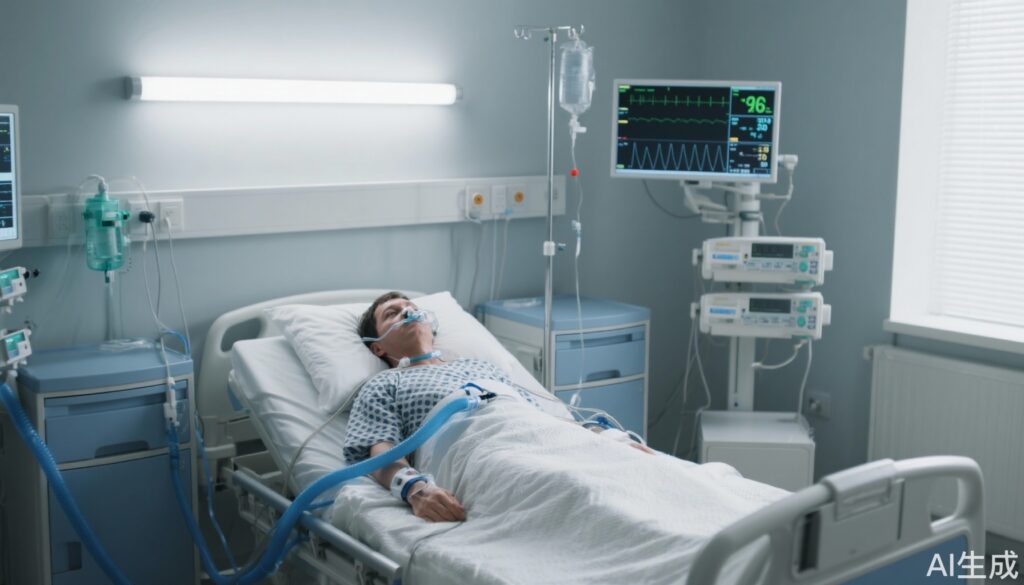Highlight
– Prolonged hospitalization (PLOS) post-hematopoietic cell transplantation (HCT) is associated with worse pre-transplant quality of life (QOL), symptom burden, and depression.
– Patients experiencing PLOS exhibit sustained worse QOL, elevated symptom burden, and depressive symptoms up to six months after transplantation.
– PLOS is linked to increased risk of mortality and rehospitalization within the first year post-HCT.
– Identifying patients at risk for PLOS allows prioritization of augmented supportive and palliative care interventions.
Study Background and Disease Burden
Hematopoietic cell transplantation (HCT) is a potentially curative treatment for various hematologic malignancies. Despite its therapeutic promise, HCT is a complex procedure involving intensive conditioning regimens and substantial risks, often necessitating prolonged inpatient stays. Extended hospitalization can result from complications such as graft-versus-host disease, infections, or organ toxicities. Prolonged length of stay (PLOS) during the HCT hospitalization poses additional clinical challenges, including increased healthcare resource utilization, risk of nosocomial infections, and psychological distress. Patient-reported outcomes (PROs) such as quality of life (QOL), symptom burden, and mental health are critical to understanding patients’ overall well-being but remain underexplored in the context of PLOS post-HCT. This study addresses the gap by evaluating clinical and demographic factors linked to PLOS and examining the association of PLOS with longitudinal PROs and clinical outcomes after transplantation.
Study Design
This analysis is a secondary evaluation of a combined cohort from one prospective observational study and two randomized clinical trials focusing on integrated specialty palliative care during HCT hospitalization. The study population included 606 adult patients (mean age 55.7 years; 56.6% male; 81.5% White) with hematologic malignancies who underwent autologous or allogeneic HCT. Prolonged length of stay was defined as ≥30 continuous days for allogeneic HCT recipients and ≥21 continuous days for autologous recipients.
Patient-reported outcomes measured included:
- Quality of Life (Functional Assessment of Cancer Therapy Bone Marrow Transplant [FACT-BMT])
- Symptom burden (Edmonton Symptom Assessment Scale)
- Anxiety and depression (Hospital Anxiety and Depression Scale and Patient Health Questionnaire-9)
- Posttraumatic stress symptoms (PTSD Checklist [PCL])
PROs were assessed at baseline (admission, pre-HCT), 2 weeks, and 3 and 6 months post-HCT.
Statistical approaches included multivariate logistic regression to identify associations between pre-HCT PROs and PLOS, linear mixed-effects models to evaluate longitudinal PRO trajectories by PLOS status, and Cox proportional hazards regression to explore differences in time to rehospitalization or death during the first post-HCT year.
Key Findings
Demographic and Clinical Characteristics Associated with PLOS:
- Patients with PLOS were significantly younger (mean age 53.3 vs 56.6 years; P = .004).
- Higher prevalence of complete remission status prior to HCT (52.8% vs 46.3%, P = .02).
- More frequently diagnosed with acute leukemia (34.2% vs 26.1%, P < .001).
- Underwent allogeneic transplantation more commonly than those without PLOS (62.1% vs 49.9%, P < .0001).
Pre-HCT Patient-Reported Outcomes and Risk of PLOS:
- Worse baseline quality of life correlated with increased PLOS risk (odds ratio [OR] 0.99 per unit increase on FACT-BMT, P = .003).
- Greater symptom burden pre-HCT increased odds of PLOS (OR 1.02, P = .01).
- Higher baseline depressive symptoms predicted higher risk for PLOS (OR 1.07, P = .01).
Trajectory of PROs Post-HCT by PLOS Status:
- Compared to patients without PLOS, those with PLOS exhibited significantly worse quality of life at 2 weeks (mean difference ∆ = -12.3, P < .0001), 3 months (∆ = -6.9, P = .002), and 6 months (∆ = -4.8, P = .02) post-HCT.
- Symptom burden remained elevated in PLOS patients at 2 weeks (∆ = 10.2, P < .0001) and 3 months (∆ = 3.9, P = .04), but this difference resolved by 6 months (∆ = 0.5, P = .79).
- Depressive symptoms were higher at 2 weeks (∆ = 2.5, P < .0001) and 3 months (∆ = 1.1, P = .03) post-HCT in PLOS patients, with no significant difference at 6 months (∆ = 0.6, P = .19).
Clinical Outcomes:
- PLOS was associated with a shorter time to death or rehospitalization within the first year post-HCT (median 221 days vs not reached; hazard ratio 1.7, 95% CI 1.3 to 2.2, P < .001).
Expert Commentary
This robust multicenter cohort analysis elucidates the pivotal role of baseline patient-reported outcomes in predicting prolonged hospital stays among HCT recipients, highlighting a critical intersection of clinical and psychosocial factors. The association between worse baseline QOL, elevated symptom burden, and depressive symptoms with PLOS underscores the necessity for comprehensive pre-transplant assessments incorporating PRO measures. Such evaluations can identify vulnerable patients at risk for extended inpatient care, allowing targeted supportive interventions.
The persistence of worse QOL and symptom/depression burden up to six months post-transplant signals that PLOS is not merely an inpatient phenomenon but a marker for prolonged morbidity and psychological distress. This finding advocates for integrated multidisciplinary care models that extend beyond discharge, incorporating symptom management, mental health support, and rehabilitation tailored to the PLOS subgroup.
Clinicians should also note the increased risk of rehospitalization and mortality associated with PLOS, emphasizing the importance of post-discharge vigilance and care coordination. While the study is strengthened by its prospective design and adjustment for confounders, limitations include potential selection bias given the trial setting and demographic homogeneity, which may impact generalizability.
Conclusion
Prolonged hospitalization following hematopoietic cell transplantation is intricately associated with pre-transplant patient-reported quality of life, symptom burden, and depression. Patients experiencing PLOS endure sustained deficits in QOL and psychosocial well-being and face higher risks of mortality and readmission in the subsequent year. Early identification of at-risk patients through comprehensive PRO assessments could inform personalized supportive care strategies to mitigate PLOS and improve long-term outcomes. Future research should explore targeted interventions during and after HCT hospitalization tailored to the unique needs of this high-risk population.
References
Gao L, Nelson A, Barata A, Horick N, Wekwerth B, Wood A, Fernandes A, Lee SJ, LeBlanc TW, Amonoo HL, El-Jawahri A, Newcomb R. Prolonged Hospitalization for Hematopoietic Cell Transplantation: Characteristics, Risk Factors and Associations with Patient-Reported and Clinical Outcomes. Transplant Cell Ther. 2025 Sep;31(9):697.e1-697.e12. doi: 10.1016/j.jtct.2025.05.026. Epub 2025 Jun 10. PMID: 40505814; PMCID: PMC12357325.



